Antique Desks & Writing Tables Buying Guide
Our current collection of antique desks and writing tables may not always be extensive, but it remains one of our strongest-selling categories. The best examples rarely hang around long.
Whether you’re furnishing a dedicated library, adding gravitas to a modern workspace or replacing something flimsy and forgettable, this collection brings together the best of traditional English craftsmanship. Craftsmanship that endures where trends do not.
Choosing the right antique desk or writing table involves more than picking a style you like. Scale, structure, function and period features all play a part in how well a piece will suit your space and your needs. This guide breaks down the key types, materials and design details to look for. It will help you understand what makes each desk distinctive and what to consider before you buy.
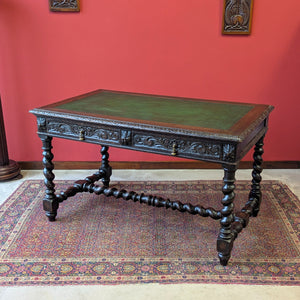
Types of Antique Desks & Writing Tables
Antique desks and writing tables come in a host of forms, each designed with a particular function or setting in mind.
Getting to grips with the key types can help you choose a piece that fits your home, meets your practical needs and suits the level of decorative impact you’re after.
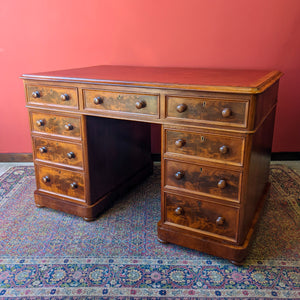
Antique Pedestal Desks
Among the most recognisable forms of antique desks are pedestal desks. They normally feature a central drawer and kneehole, flanked by banks of drawers to either side (the pedestals). The writing surface is often finished in tooled, inset leather, and in some examples, a shallow raised gallery or additional storage sits toward the rear of the top.
Typically, though not always, they were made in three sections to allow for easy transport and access. Pedestal desks were common in both domestic studies and professional offices from the late Georgian period onwards, and the form has remained in consistent use ever since.
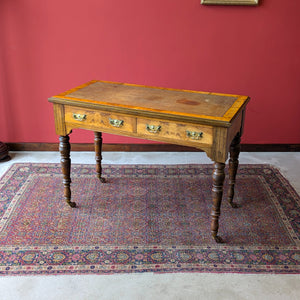
Antique Writing Tables
Antique writing tables are generally lighter in form, often with a single tier of just one or two drawers below the top and raised on slender turned legs with castors. Tops are sometimes finished in tooled leather, though polished wood is equally common.
They were mostly designed for occasional use in drawing rooms or libraries, rather than for intensive clerical work. Even so, they were built with the quality and durability expected of fine cabinetmaking and remain more than capable of handling regular use in the home.
Writing tables were sometimes finished on all sides, intended to sit freely within a room. Where this is the case it can make them well suited to modern interiors that favour open layouts and flexible furniture placement.
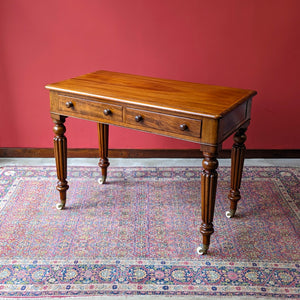
Today, antique writing tables appeal as much for their versatility as their appearance. Their lighter construction and more open aesthetic make them our most popular choice of writing surfaces for the home. While offering far less storage, they offer considerably greater ease of placement and mobility.
Their reduced scale when compared to more traditional desks make them well suited to sitting a range of secondary uses and positions, like behind a sofa, beneath a window or even in a hallway. Whether used as a laptop desk, dressing table or occasional console, they bring refinement and order to a space without feeling too heavy or overbearing.
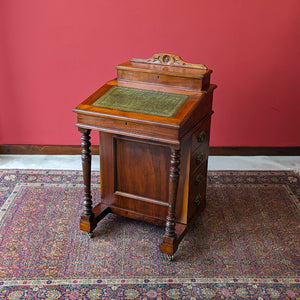
Antique Davenport Desks
Davenports normally feature a sloped inset leather hinged writing surface which lifts open to reveal fitted internal storage. Most examples include four or five working drawers on one side, with corresponding faux drawer fronts on the opposite side for symmetry. The rear section of the top is commonly fitted with a raised gallery or stationary compartments, adding both utility and visual interest.
Compact and instantly recognisable, the style first appeared in the late 18th to early 19th century. Tradition links the name to a Captain Davenport who is said to have commissioned the original design from Gillows of Lancaster, however no firm historical record of this individual survives.
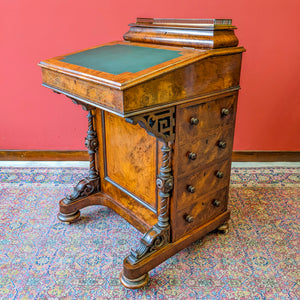
The Davenport quickly gained popularity in the home due to its small footprint and unique silhouette. It was especially popular in Victorian homes, often used in living rooms or bedrooms rather than formal studies.
Practical, easily placed and often beautifully decorative, crafted in fine walnut or mahogany.
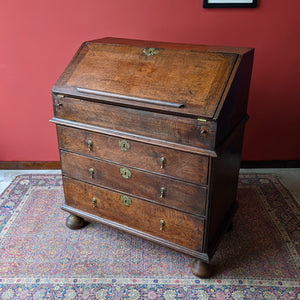
Antique Bureau Desks or Fall-Front Desks
Coming in a huge range of sizes and styles, bureau desks normally combine a writing surface and storage. The hinged fall-front folds away when not in use, making them well suited to smaller rooms and helping to keep a space neat without compromising on function.
Sometimes with an inset leather writing surface, they often feature pigeonholes and some small drawers inside. Typically this kind of desk was designed for more domestic settings rather than commercial.
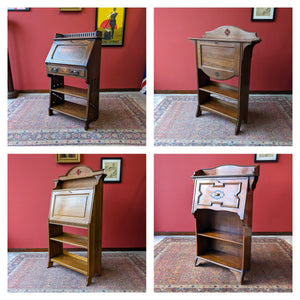
Antique Bureau Bookcases
A subsection of the broader bureau category is the ever-popular bureau bookcase, sometimes known as a “student’s desk”. These compact, often incredibly shallow pieces combine a fall-front writing surface with a bookcase or shelving section below, offering both workspace and storage in a remarkably efficient footprint.
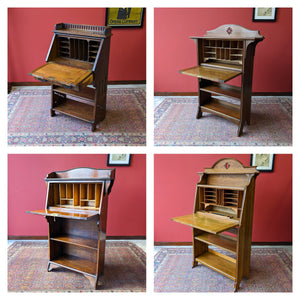
Originally intended for smaller studies, bedrooms or student lodgings, their vertical structure makes them especially well suited to tight spaces, while still providing a dedicated area for correspondence or writing, now, of course, perfectly suited to laptop use.
Today, they’re appreciated for their compact elegance and versatility. A smart solution for homes without a dedicated office, for living rooms where a desk is occasionally needed, or anywhere space is at a premium.
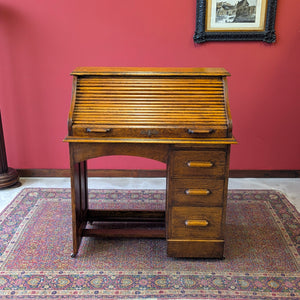
Antique Roll Top Desks
Distinctly recognisable by their tambour shutter that rolls down to conceal the working surface, roll-top desks became popular in the late 19th and early 20th centuries. Typically constructed in oak and fitted with multiple pigeonholes and drawers, they were favoured in offices and schools for their ability to secure documents while keeping everything within easy reach.
Today, they offer practicality and a particular aesthetic which remains popular. Variations on this theme include the cylinder desk and fold top desks.
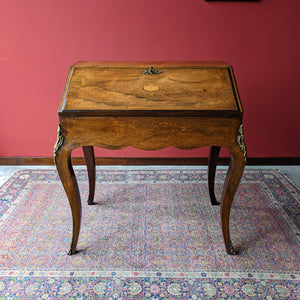
Antique Bureau de Dames
A more decorative cousin of the bureau, the Bureau de Dames is a small, elegant writing desk often associated with French design but also produced in England during the 18th and 19th centuries. Typically feminine in proportion and detailing, these pieces often feature curved cabriole legs, serpentine or bombe fronts and marquetry or inlay work.
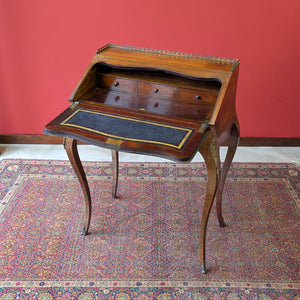
The writing surface is usually concealed behind a fall-front top, with small drawers and pigeonholes revealed when opened. Designed more for correspondence and refinement than heavy clerical use, they were often placed in bedrooms, drawing rooms or boudoirs.
Today, they appeal for their charm, delicacy and versatility, making ideal statement pieces in dressing rooms, quiet corners or anywhere a lighter desk is desired.
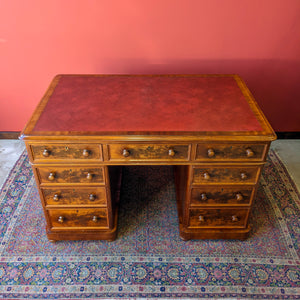
Antique Partners’ Desks
Partners’ desks are large, double-sided versions of the pedestal desk, originally designed for shared use. They typically feature a central kneehole on each side, with drawers or cupboards facing outwards on both fronts, allowing two people to sit opposite each other. These desks were most commonly used in legal offices, banks or commercial environments where collaborative work was the norm.
Statement pieces ideal for large studies or libraries, and built on a grander scale than standard pedestal desks, partners’ desks often have deeper tops, additional storage and a more commanding presence.
Though originally practical in nature, partners’ desks are now often appreciated for their architectural form and imposing stature. They serve as striking centrepieces and remain highly functional for anyone looking for a serious working desk with real weight and gravitas.
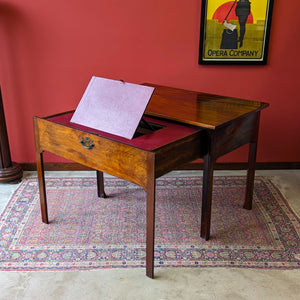
Antique Architects’ Desks
Architects’ desks were designed to accommodate large-format drawings and precision work, often featuring an angled or adjustable top supported by a robust base. Most surviving examples date from the late 19th to early 20th century but earlier examples sometimes come up, like the one pictured.
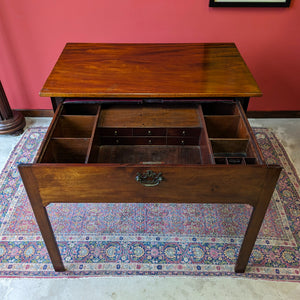
Most often built in oak, ash or mahogany, some include integrated drawers, shelving, or tool wells, and many show the honest wear of working life. These are substantial, characterful pieces, ideal for use as statement desks, studio workstations or striking decorative elements in lofts and creative interiors.
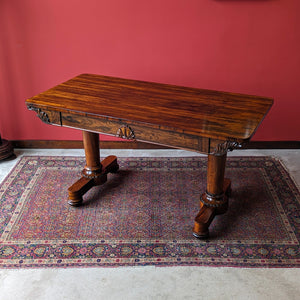
Antique Library Tables
While not technically a desk, the library table comfortably falls within this category due to its scale, form and intended function. These broad, freestanding tables were typically found in grand 18th and 19th-century country house private libraries, studies and drawing rooms, most often crafted in the finest rosewood or mahogany.
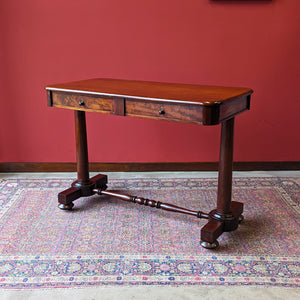
Most feature a flat top with one or two frieze drawers and often a particularly decorative base. Though originally designed for reading and writing, many now serve equally well as writing tables or centre tables.
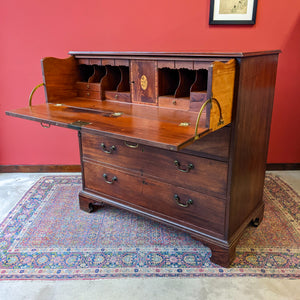
Antique Secretaire Desks
A secretaire desk is one which conceals a writing compartment behind a fall-front or drop-down panel, often incorporated into a chest of drawers. When closed, it presents as a solid storage piece, but when opened, it reveals a writing surface and typically internal storage, pigeonholes or even hidden compartments.
Combining practical storage with discreet functionality, the secretaire is ideal for rooms where a more formal, tidy appearance is desired.
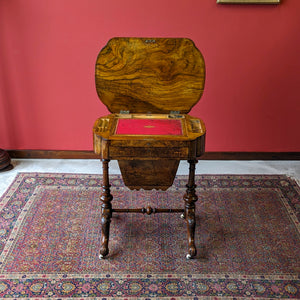
Antique Sewing Tables with Writing Slopes
Designed primarily for needlework, some 19th-century sewing tables occasionally included a writing surface, allowing the piece to serve a dual purpose. Typically compact and finely constructed in walnut, mahogany or rosewood, these tables often feature a central work basket, small drawers for threads and tools and a flat inset leather surface for occasional correspondence.
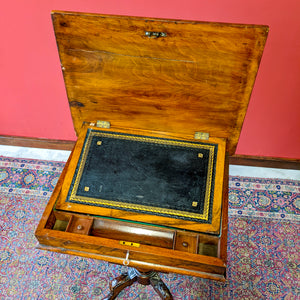
Favoured in well-appointed Victorian homes, they reflect a period when furniture was increasingly tailored to women’s activities and combined refinement with discreet practicality.
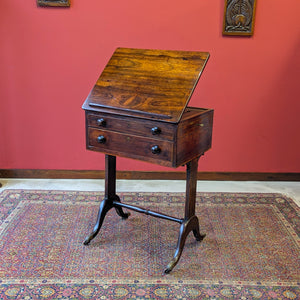
Antique Reading Tables
Reading tables were designed for use while standing or seated, often with adjustable angled tops to support books, maps or documents. Again, not technically desks, but they fall within this category as functional working furniture, typically used in libraries, studies and ecclesiastical settings.
Most examples date from the 18th and 19th centuries and are constructed in fine rosewood, mahogany or walnut. Some include candle slides, drawer compartments, or ratcheted mechanisms to alter the reading angle. Today, they’re valued for their distinctive purpose-driven design and are often repurposed as decorative accent pieces or lecterns.
Each type of desk or writing table has its own visual language, proportions and practical considerations. Whether you're after drawer space, visual lightness or a commanding centrepiece, the structure of the desk will play a key role in how it works in your home.
Desks & Writing Tables by Period: Georgian, Regency, Victorian or Edwardian?
Antique desks and writing tables evolved significantly across the centuries, shaped by changing materials, working habits and decorative tastes. Particular period characteristics can guide you towards a desk that suits your interior and the way you intend to use it.
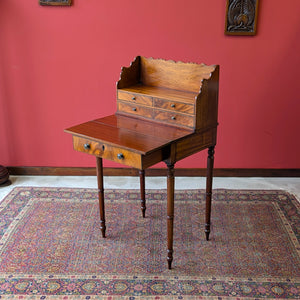
Antique Georgian Desks (1714–1830)
Georgian desks and writing tables are renowned for their robust construction, restrained style and fine timber quality, typically made in mahogany, walnut or oak. Early examples can be wonderfully understated and unornamented, while pieces from the early 19th century occasionally show more decorative flourishes, often reflecting the tastes or setting they were made for.
Common forms include bureaus, kneehole desks, early pedestal desks and neat writing tables with turned legs. Georgian pieces have a quiet, architectural presence that suits both traditional and modern interiors, particularly in rural country homes or cottage settings.
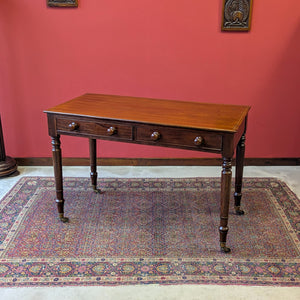
Antique Victorian Desks (1837–1901)
A pivotal era for desks and writing tables, Victorian examples varied widely in form and style, perfecting and popularising many of the key types. Writing tables also became more widespread and accessible during this time, reflecting the growing demand for both functional and decorative furniture within the home.
Victorian desks and writing tables were made for a broad range of settings, from domestic writing and correspondence to professional use in clerks’ offices, private banks, libraries and institutions.
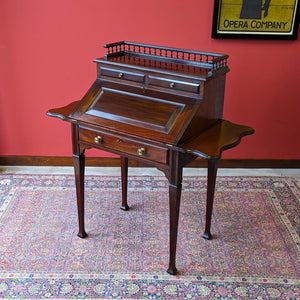
In the home, they offered a dedicated space for letter writing, reading or household management, often placed in a study, drawing room or bedroom.
In the workplace, desks were designed with function, presence and durability in mind, built to withstand daily use while reinforcing a sense of authority.
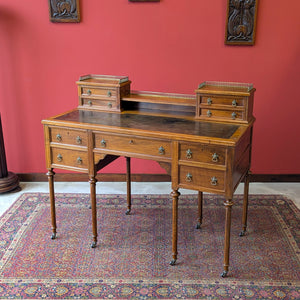
Whether placed in a gentleman’s study, a lady’s boudoir or at the heart of a commercial operation, these pieces were not only practical but often designed to convey status, modernity and a sense of progress.
Some Victorian designs are highly decorative, while others remain relatively restrained, especially in earlier pieces. Elaborate examples with cabriole legs, moulded panels, or shaped pedestals reflect the influence of Gothic Revival and Rococo styles, often seen in walnut or ebonised finishes. In contrast, simpler models in mahogany or oak tend to favour clean lines and modest proportions.
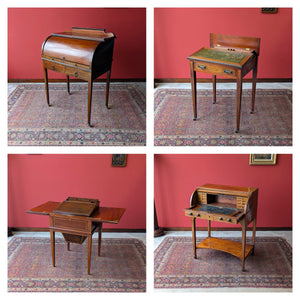
Later Victorian desks embraced more complex forms, including metamorphic designs and cylinder-top constructions, reflecting both a spirit of innovation and the influence of continental European styles.
This diversity means there’s a Victorian desk to suit nearly any interior, from richly furnished studies to lighter, utility-focused home offices.
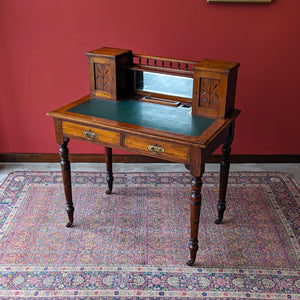
Antique Edwardian Desks (1901–1910)
Edwardian desks retained many of the established Victorian forms but introduced a noticeably lighter aesthetic, often shaped by the ideals of the Arts & Crafts and Art Nouveau movements.
This was a period of refinement rather than reinvention, where traditional shapes were reinterpreted with cleaner lines, more delicate proportions and a greater emphasis on subtle detailing. Fine stringing, geometric or floral inlay, and occasional use of contrasting woods reflect the period's interest in craftsmanship and decorative details.
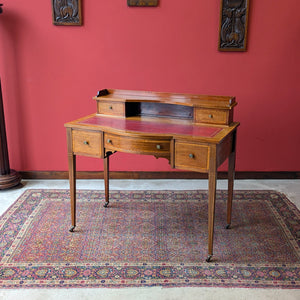
The growing use of mechanised tools in cabinetmaking also allowed for greater precision and consistency, which can be seen in the fine drawer construction, shaped aprons and smoothly integrated tambour fronts occasionally found in Edwardian writing furniture. While many designs echoed earlier Georgian or Regency influences, their execution often feels lighter and more modern, reflecting changing tastes and the needs of an increasingly mobile and professional middle class.
Writing tables and kneehole desks from this period are typically straightforward, elegant and highly usable, making them well suited to contemporary interiors where understated design and daily function are equally valued.
What to Look For in an Antique Desk or Writing Table: Materials, Proportions & Condition
Buying an antique desk or writing table requires weighing up lots of factors related to your intended use, your room layout, your stylistic preferences and the functions you need it to serve.
Material, legroom, drawer capacity and surface condition all matter, but so does the feeling the desk gives you. You will likely end up spending more time with this piece than any other item in the room, so take your time to find the right one. Choose one that works, looks right, and rewards you every time you sit down.
The beauty of antique furniture is that each and every piece is unique, however there are good consistent markers of craftsmanship, authenticity and usability that will help guide your decision. Understanding what to look for in materials, proportions and condition will help you find a desk that fits your interior and holds up to the demands of daily life.
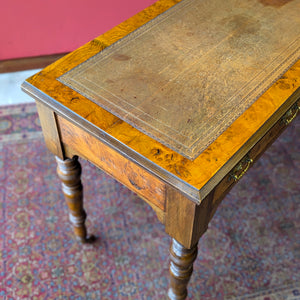
Materials & Timber Quality
The best desks and writing tables are usually constructed from solid hardwoods such as mahogany, oak or walnut, often with original or professionally restored leather or baize writing surfaces. That said, many prefer the informal simplicity, natural beauty and undeniably more versatile appeal of a polished wood top.
Look for well-figured timber and signs of honest age, such as richly worn leather tops, softened edges and a mellowed patina.
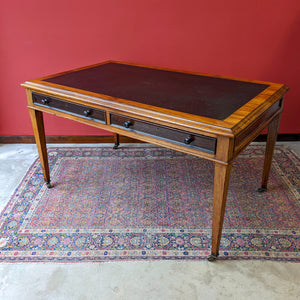
Proportions & Usability
Good proportion isn’t just visual, it influences how naturally the piece fits into your working and home life. Check that any kneehole is wide and high enough for comfortable use.
Consider the desk’s depth and width, how far you’ll need to reach both front to back and side to side, and whether the overall scale suits your room.
Storage is an important consideration, and your needs here will largely determine the right type of desk. If you require extensive storage, a pedestal or partners’ desk with multiple drawers may be ideal. If you only need to keep a few files or essentials close to hand though, the more modest drawer space of a writing table can offer greater freedom and a lighter presence.
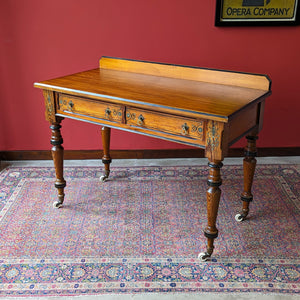
Construction, Functionality & Access
Traditional antique pedestal desks were typically built in sections, two pedestal bases and a separate top, to allow for easy movement. Where access is tight, this construction means large, substantial desks can be brought into spaces they’d otherwise never reach.
Writing tables on the other hand are constructed in one piece, but the open leg structure normally allows for easy access into almost any room in the home.
We ensure all of our desks and writing tables are structurally sound, free from wobbles or instability, but this is something worth checking when buying elsewhere. Signs of old repairs aren’t necessarily a negative, provided they’ve been done properly and allow the piece to function as intended.
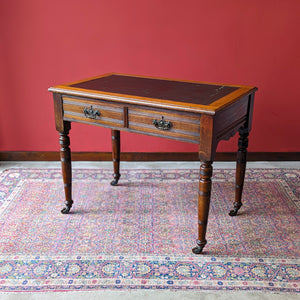
Surface Condition & Finish
Desks are made to be used. Desks have a job to do, and most of ours have been doing it reliably for over a hundred years, so signs of use and surface wear are to be expected, and in most cases, admired.
Few things are more beautiful than a finely aged leather writing surface or the softened edge of a well-worn desktop. Original finishes are ideal, but wood can also be refinished sympathetically and traditionally, preserving both its character and long-term usability.
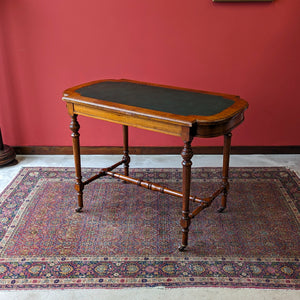
Authenticity & Age
Every desk and writing table we sell is listed with full details of period, wood, and classification, so you can be confident that what you’re getting is exactly as described. With most reputable dealers, authenticity shouldn’t need to be a major concern, but when sourcing from less established routes, it’s something worth scrutinising more closely.
Antique Desk & Writing Table FAQs
Can antique desks be used today?
Absolutely. Most antique desks and writing tables are perfectly suited to modern working, and they almost always outperform the vast majority of newer alternatives. If a piece has been in regular use for over a century, there's rarely a reason it can’t continue. Nearly all options are well suited to writing, laptop or desktop computer use, just choose one with the right size and storage for your needs.
Will a pedestal desk fit through my doorway?
Most are built in three sections, making them easier to move through tight spaces, so access won’t be an issue in most homes. We’ll always note whether this is the case in a listing but it’s something to check when buying elsewhere.
Are antique desks comfortable to sit at?
Yes, most definitely. Comfort is of course subjective, but desks don’t survive 100-200 of use unless they work well. Just check the height, legroom and drawer layout is suitable for your setup.
Do writing tables have enough storage?
They usually offer a couple of decent sized drawers so unless you’re doing something particularly paper-heavy they can be ideal for most modern workspaces.
Can I use an antique desk with a laptop or desktop computer?
Yes absolutely, most antique desks or writing tables accommodate a laptop or a desktop computer comfortably.
Do antique desks work well in modern interiors?
Absolutely. Their clean lines and character often pair beautifully with contemporary spaces.
Is surface wear on an antique desk a problem?
No, signs of use are expected and often desirable. They add character and show honest age.
What’s the difference between a desk and a writing table?
Desks typically have more drawers and storage; writing tables are lighter with open legs.
What is a Davenport desk?
A small, upright 19th-century desk with a sloped lift up top, usually with drawers on one side.
Is a library table the same as a writing table?
Not quite, but they can serve the same purpose. Library tables are usually larger and often feature a stretcher joining the legs for added stability.
What woods are most common in antique desks?
Mahogany, oak and walnut are the most frequently used, often with fine grain and colour. Antique Library tables are very often but not always made with finer rosewood.
Are secretaire desks and bureau desks the same?
Similar, but not the same. A bureau has a sloped fall-front, while a secretaire usually has a flat front and is designed to resemble a chest of drawers or cabinet.
Can antique desks be used for working from home (WFH)?
Yes, most were built for daily use and are ideal for modern work with laptops, home computers and paperwork.
Why do some desks have fake drawers?
Purely for aesthetics or symmetry. One side may house working drawers, the other, faux drawer fronts to match.
Every antique desk and writing table in our collection is chosen for its craftsmanship, character and utility, each one ready to work hard while look good doing it.
If you see something that suits your space (and your ambition), you can buy online with UK delivery included. Prefer to chat first? We’re always happy to talk desks, get in touch with any questions.






















